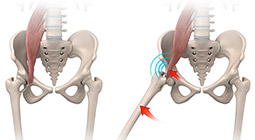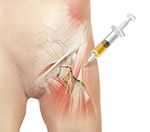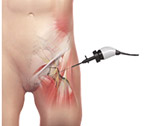Snapping Hip Syndrome
Hip Anatomy
The hip is an important joint that helps us walk, run and jump. The ball-and-socket joint of the hip is formed by the round end of the femur (thighbone) and the cup-shaped socket of the acetabulum (part of the pelvis). Stability of the hip joint is achieved by the labrum (a strong fibrous cartilage that covers the acetabulum and seals it), ligaments (tissues connecting bone to bone) and tendons (tissues connecting muscle to bone) that encase the hip and support the hip movements.
What is Snapping Hip Syndrome?
Snapping hip syndrome is a condition in which you hear or feel a snapping sound in the hip when you swing your legs, run, walk or get up from a chair. The sound can be experienced in the back, front or side of the hip.
Symptoms of Snapping Hip Syndrome
Snapping hip syndrome is usually harmless, but may be accompanied with pain and weakness. Sometimes, the syndrome can lead to bursitis, a painful swelling of the fluid-filled sacs called bursae that cushion the hip joint.
Causes of Snapping Hip Syndrome
The movement of muscles or tendons over a bony protrusion in the hip region gives rise to the snapping sound. The most common cause of snapping hip syndrome is tightness in the muscles and tendons surrounding the hip. Sometimes, a loose piece of cartilage, a cartilage tear or pieces of broken cartilage or bone in the joint space can cause the snapping sound. This may also lock the hip, causing disability along with the pain. However, this is less common. Sports or dance activities that involve repeated bending make you vulnerable to snapping hip syndrome. It may affect your performance.
Diagnosis of Snapping Hip Syndrome
Your doctor will review your medical history and symptoms and conduct a physical examination to detect the exact cause of snapping. You may be required to reproduce the snapping sound by moving your hip in different directions. Imaging tests may be ordered by your doctor to rule out bone and joint problems.
Treatments for Snapping Hip Syndrome
Rest and modification of activities may be suggested initially by your doctor followed by conservative therapeutic options. The therapeutic strategies for snapping hip include:
Home Care
A few home remedies can be followed if you experience minor snapping hip pain, which include:
- Applying ice to the affected area
- Using NSAIDs to reduce discomfort
- Avoiding repetitive hip movements by changing your activities
Consult your doctor if the discomfort persists even after following the home remedies.
Physical Therapy
Your doctor may teach you certain exercises to strengthen and stretch the musculature surrounding the hip. You may be guided by a physical therapist. Tendon stretching exercises such as iliotibial band stretch and piriformis stretch will be indicated depending on the type of snapping you experience.
Corticosteroid Injection
Your doctor may recommend a corticosteroid to be injected into the bursa to reduce the pain and inflammation in the hip joint in case you have hip bursitis.
Surgical Treatment
Surgery is recommended when conservative approaches do not have an effect in resolving the snapping hip syndrome (which is rare). The type of surgery will depend on the factors that cause the syndrome. Surgical procedures include:
- Open procedure: An open incision of several centimeters will be made to resolve the issue of snapping hip. The open surgery can help your surgeon to gain better access to the hip problem.
- Hip arthroscopy: This procedure is usually performed to remove or repair the torn labrum. Your surgeon will insert an arthroscope (small camera) into your hip joint so that minute surgical instruments can be guided with the help of real-time image that is displayed on a large screen. Very small cuts are required for this procedure due to the presence of a small arthroscope and surgical instruments.
Your surgeon will discuss the best surgical option depending on your condition.








